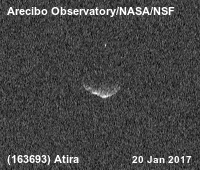 | |
| Discovery[1] | |
|---|---|
| Discovered by | LINEAR |
| Discovery site | Lincoln Lab ETS |
| Discovery date | 11 February 2003 |
| Designations | |
| (163693) Atira | |
| Pronunciation | /əˈtɪrə/ Pawnee: [ətíɾəʔ] |
Named after | Atíraʼ "my/our mother"[1] (Pawnee epithet of the earth goddess)[2] |
| 2003 CP20 | |
| Symbol | |
| Orbital characteristics[3] | |
| Epoch 23 March 2018 (JD 2458200.5) | |
| Uncertainty parameter 0 | |
| Observation arc | 14.21 yr (5,192 d) |
| Aphelion | 0.9798 AU |
| Perihelion | 0.5024 AU |
| 0.7411 AU | |
| Eccentricity | 0.3221 |
| 233 days | |
| 30.769° | |
| 1° 32m 41.64s / day | |
| Inclination | 25.618° |
| 103.90° | |
| 252.93° | |
| Known satellites | 1[4][5][6][7] |
| Earth MOID | 0.2076 AU (80.88 LD) |
| Physical characteristics | |
| 4.8±0.5 km[4][5][6][7] | |
| 3.3984±0.0006 h[7] | |
Pole ecliptic latitude | −50°[8] |
Pole ecliptic longitude | 192°[8] |
| 0.0231 (derived)[7] | |
| S (assumed)[7] | |
| 16.3[3][7][9] | |
163693 Atira (/əˈtɪrə/; provisional designation 2003 CP20) is a stony asteroid, dwelling in the interior of Earth's orbit. It is classified as a near-Earth object. Atira is a binary asteroid, a system of two asteroids orbiting their common barycenter. The primary component with a diameter of approximately 4.8 kilometers (3 miles)[7] is orbited by a minor-planet moon that measures about 1 km (0.6 mi).[4] Atira was discovered on 11 February 2003, by astronomers with the Lincoln Near-Earth Asteroid Research at Lincoln Laboratory's Experimental Test Site near Socorro, New Mexico, in the United States.[1][10]
It is the namesake and the first numbered body of the Atira asteroids, a new subclass of near-Earth asteroids, which have their orbits entirely within that of Earth and are therefore alternatively called Interior-Earth Objects (IEO).[3][11][12] As of 2019, there are only 36 known members of the Atira group of asteroids.[13] Atiras are similar to the larger group of Aten asteroids, as both are near-Earth objects and both have a semi-major axis smaller than that of Earth (< 1.0 AU). However, and contrary to Aten asteroids, the aphelion for Atiras is always smaller than Earth's perihelion (< 0.983 AU),[14] which means that they do not approach Earth as close as Atens do in general. Atira has an Earth minimum orbit intersection distance of 0.2059 AU (30,800,000 km) or approximately 80.1 lunar distances.[3]
- ^ a b c d Cite error: The named reference
MPC-objectwas invoked but never defined (see the help page). - ^ Douglas Parks & Lula Pratt, A Dictionary of Skiri Pawnee, University of Nebraska Press, 2008. atira, AISRI Dictionary Database Search, Indiana University.
- ^ a b c d e Cite error: The named reference
jpldatawas invoked but never defined (see the help page). - ^ a b c Cite error: The named reference
radar-discoverywas invoked but never defined (see the help page). - ^ a b Cite error: The named reference
johnstonsarchivewas invoked but never defined (see the help page). - ^ a b Cite error: The named reference
Rivera-Valentin-2017was invoked but never defined (see the help page). - ^ a b c d e f g Cite error: The named reference
lcdbwas invoked but never defined (see the help page). - ^ a b Cite error: The named reference
Deleon2023was invoked but never defined (see the help page). - ^ Cite error: The named reference
NEODySwas invoked but never defined (see the help page). - ^ Cite error: The named reference
lincolnwas invoked but never defined (see the help page). - ^ Cite error: The named reference
Johnstonwas invoked but never defined (see the help page). - ^ Cite error: The named reference
Shoemaker-1983was invoked but never defined (see the help page). - ^ de la Fuente Marcos, Carlos; de la Fuente Marcos, Raúl (1 August 2019). "Understanding the evolution of Atira-class asteroid 2019 AQ3, a major step towards the future discovery of the Vatira population". Monthly Notices of the Royal Astronomical Society. 487 (2): 2742–2752. arXiv:1905.08695. Bibcode:2019MNRAS.487.2742D. doi:10.1093/mnras/stz1437.
- ^ Cite error: The named reference
jpl-groupwas invoked but never defined (see the help page).